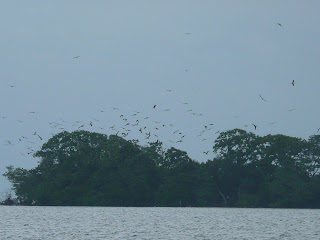or Bay-LEE-Say, as the Mexicans say. Sounds more melodic and seductive that way, I think. Here’s the view from Spanish Lookout Cay toward the mainland the night we arrived.
Getting out of Mexico at Puerto Morelos took all day, but eventually the Port Captain got all the stamps he wanted. Unfortunately, it meant we had to leave with pesos rather than groceries.
The two hundred miles to Belize City took us 56 hours, which is a long time to be a little uncomfortable. The wind never really got on the nose, and never more than 20 knots, and the squalls all missed us and the ships all announced their presence early on and the temperature never went below 70 and there was a good moon and nothing weird happened beyond especially ‘devil’ waters from place to place.
But there was a consistent current of at least two knots straight against us, all the time. What always felt like a good six knots of forward progress turned into something less than four. We constantly lurched into hard stand-up waves, and rolled, and slapped, ad infinitum, although not quite ad nauseum. Bulkheads creaked, and the walls of the nearly-full water tanks under the settees pooched in and out, and salty damp settled everywhere.
Luckily, the Milky Way made a stellar appearance, and later the moon, with it’s usual “Yikes!” moment. Next day we heard euphoric reports from the northbound boats “we were flying, over ten knots sometimes, so much fun we just kept going…..”
But for us, southbound, this passage was something of a chore. However our pet ants really got riled up. We’ve had a few ants since we left Maryland, little fast ones, and bigger but more charismatic mediums, with jaunty antennae and perky pointed abdomens. My inner anthropologist was trying to figure out if they were getting together, what their tastes and habits were, etc. If they appeared in the galley, however, I’d casually wipe them out.
In the middle of the first rough night, caravans of ants appeared, trekking single file through the cabin in both directions along the starboard side where the cabin sides meet the top. Like a vengeful goddess (although I saw myself more as a research scientist), I smote them, sparing only those who seemed to be passing messages or who carried something white. All night long, they passed, and I smote, disrupting convoys , until my watch was finished.
In the morning the field of combat switched to the galley, the ants having apparently abandoned the starboard flank. The war of attrition continued throughout the day, as I threw my lightning bolt, pointed my fickle finger, even used weapons of mass destruction such as the blade of a knife in a gap along the trim.
Well, I’ve pretty much got them all, I thought, and I’m a little sorry because I enjoyed their presence, before they got uppity. That was yesterday.
Today, the larger ants have retreated to an undisclosed port-side location, where they are apparently digging bunkers and filling the sandbags, because our Forensics department has identified piles of frass and masonite dust.
“They’re eating the boat” Doug says. “You’ve got to do something.”

So I’ve concocted a tasty, pasty potion, honey and boric acid, and applied it in a place where I can watch what happens. But insects will inherit the earth, so I don’t think this will be the end of it. Meantime, we’ve got to get legal in Bay-LEE-Say.
 So it happened that we were blowing downwind under the genoa ‘admiring’ the patches of turtle grass and shadow in the nice green water. We always watch the sounder – it’s like a sick fascination with those single digit numbers, but I was almost inured when: THUMP. Then:, thump, thump, THUMP. And we settled over to port, water lapping at the rubbing strake, hard aground, being set on, and not sure what we had hit, beyond the turtle grass we could clearly see all around us
So it happened that we were blowing downwind under the genoa ‘admiring’ the patches of turtle grass and shadow in the nice green water. We always watch the sounder – it’s like a sick fascination with those single digit numbers, but I was almost inured when: THUMP. Then:, thump, thump, THUMP. And we settled over to port, water lapping at the rubbing strake, hard aground, being set on, and not sure what we had hit, beyond the turtle grass we could clearly see all around us














